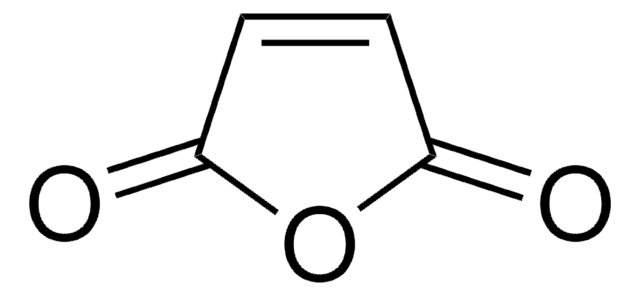377171
1,2-Epoxyhexane
97%
Synonym(s):
1-Hexene oxide, Butyloxirane
Sign Into View Organizational & Contract Pricing
All Photos(1)
About This Item
Empirical Formula (Hill Notation):
C6H12O
CAS Number:
Molecular Weight:
100.16
Beilstein:
102568
EC Number:
MDL number:
UNSPSC Code:
12162002
PubChem Substance ID:
NACRES:
NA.23
Recommended Products
Quality Level
Assay
97%
form
liquid
impurities
<3% acetic acid
refractive index
n20/D 1.406 (lit.)
bp
118-120 °C (lit.)
density
0.831 g/mL at 25 °C (lit.)
storage temp.
2-8°C
SMILES string
CCCCC1CO1
InChI
1S/C6H12O/c1-2-3-4-6-5-7-6/h6H,2-5H2,1H3
InChI key
WHNBDXQTMPYBAT-UHFFFAOYSA-N
Looking for similar products? Visit Product Comparison Guide
Application
- Poly (epichlorohydrin-co-1, 2-epoxyhexane)–a promising precursor for an energetic azido polymer for cast-cure: Discusses the synthesis of a copolymer using epichlorohydrin and 1,2-epoxyhexane, aiming to develop an internal plasticizer for energetic applications (TM Klapötke, 2016).
- Synthesis of hierarchically porous zeolite TS-1 with small crystal size and its performance of 1-hexene epoxidation reaction: This study investigates the catalytic performance of 1,2-epoxyhexane in the preparation of intermediates for various chemical industries (M Zhang et al., 2021).
- Bioproduction of Chiral Epoxyalkanes using Styrene Monooxygenase from Rhodococcus sp. ST‐10 (RhSMO): Focuses on the enzymatic production of (S)-1,2-epoxyhexane using a biocatalyst, highlighting its potential in creating chiral epoxyalkanes (H Toda et al., 2014).
- Silica islands regulated external Ti‐site environment of TS‐1 for enhanced performance of 1‐hexene epoxidation: Explores the use of modified TS-1 catalysts to improve the selectivity and performance of 1,2-epoxyhexane in epoxidation reactions (J Yuan et al., 2023).
- Gas-phase Photocatalytic Oxidation of 1-Hexene Using Heterogeneous Semiconductor Materials: Describes the synthesis of 1,2-epoxyhexane through gas-phase photocatalytic oxidation, focusing on the selectivity and efficiency of the process (EA Kamba et al., 2023).
Signal Word
Danger
Hazard Statements
Precautionary Statements
Hazard Classifications
Acute Tox. 4 Oral - Eye Irrit. 2 - Flam. Liq. 2 - Skin Irrit. 2 - STOT SE 3
Target Organs
Respiratory system
Storage Class Code
3 - Flammable liquids
WGK
WGK 3
Flash Point(F)
59.0 °F - closed cup
Flash Point(C)
15 °C - closed cup
Personal Protective Equipment
dust mask type N95 (US), Eyeshields, Gloves
Choose from one of the most recent versions:
Already Own This Product?
Find documentation for the products that you have recently purchased in the Document Library.
W J Choi et al.
Applied microbiology and biotechnology, 54(5), 641-646 (2000-12-29)
A two-phase membrane bioreactor was developed to continuously produce enantiopure epoxides using the epoxide hydrolase activity of Rhodotorula glutinis. An aqueous/organic cascade, hydrophilic, hollow-fiber membrane bioreactor was used: (1) to carry out large-scale resolution of epoxides, (2) to continuously extract
Christopher J Backlund et al.
Acta biomaterialia, 29, 198-205 (2015-10-20)
The effect of nitric oxide (NO)-releasing dendrimer hydrophobicity on Streptococcus mutans killing and biofilm disruption was examined at pH 7.4 and 6.4, the latter relevant to dental caries. Generation 1 (G1) poly(amidoamine) (PAMAM) dendrimers were modified with alkyl epoxides to
Zhimin Xue et al.
Chemistry, an Asian journal, 12(17), 2271-2277 (2017-06-20)
Development of inexpensive, easily prepared, non-toxic, and efficient catalysts for the cycloaddition of CO
Ranjai Kumar et al.
Protein expression and purification, 79(1), 49-59 (2011-04-26)
A putative epoxide hydrolase-encoding gene was identified from the genome sequence of Cupriavidus metallidurans CH34. The gene was cloned and overexpressed in Escherichia coli with His(6)-tag at its N-terminus. The epoxide hydrolase (CMEH) was purified to near homogeneity and was
Kelli L Hvorecny et al.
Structure (London, England : 1993), 25(5), 697-707 (2017-04-11)
Pseudomonas aeruginosa secretes an epoxide hydrolase with catalytic activity that triggers degradation of the cystic fibrosis transmembrane conductance regulator (CFTR) and perturbs other host defense networks. Targets of this CFTR inhibitory factor (Cif) are largely unknown, but include an epoxy-fatty
Our team of scientists has experience in all areas of research including Life Science, Material Science, Chemical Synthesis, Chromatography, Analytical and many others.
Contact Technical Service










